Tahōtō



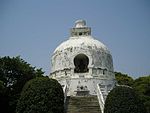


A tahōtō (多宝塔, lit. many-jewelled pagoda) is a form of Japanese pagoda found primarily at Esoteric Shingon and Tendai school Buddhist temples. It is unique among pagodas because it has an even number of stories (two). (The second story has a balustrade and seems habitable, but is nonetheless inaccessible and offers no usable space.)[1] Its name alludes to Tahō Nyorai, who appears seated in a many-jewelled pagoda in the eleventh chapter of the Lotus Sutra.[2][3] With square lower and cylindrical upper parts, a mokoshi 'skirt roof', a pyramidal roof, and a finial, the tahōtō or the larger daitō was one of the seven halls of a Shingon temple.[4] After the Heian period, the construction of pagodas in general declined, and new tahōtō became rare. Six examples, of which that at Ishiyama-dera (1194) is the earliest, have been designated National Treasures.[5] There are no examples in China, whether architectural or pictorial, of anything that resembles the tahōtō, although there is a Song dynasty textual reference to a 'tahōtō with an encircling chamber'.[6]
Hōtō
The hōtō (宝塔) or treasure pagoda is the ancestor of the tahōtō and dates to the introduction to Japan of Shingon and Tendai Buddhism in the ninth century.[2][6] No wooden hōtō has survived, albeit modern copies do exist, and stone, bronze, or iron, and specimens are always miniatures comprising a foundation stone, barrel-shaped body, pyramid roof, and a finial.[2][7]
Daitō
While the tahōtō is 3x3 ken (bays), a larger 5x5 ken version exists, known as daitō (大塔) or 'large pagoda'.[4] This is the only type of tahōtō to retain the original structure with a row of pillars or a wall separating the corridor (hisashi) from the core of the structure, abolished in smaller pagodas.[7][8] Daitō used to be common but, of all those ever built, only a few are still extant. One is at Wakayama prefecture's Negoro-ji, another at Kongōbu-ji, again in Wakayama, another at Kirihata-dera, Tokushima prefecture, another at Narita-san in Chiba. (See the respective list entries.) Kūkai himself, founder of the Shingon school, built the celebrated daitō for Kongōbu-ji on Kōyasan; almost fifty metres high, chronicles relate that 'the mightiness of its single storey outdoes that of multi-storeyed pagodas'.[3][6][9] The specimen found at Negoro-ji (see photo above) is 30.85 meters tall and a National Treasure.
Structure
Single-storey
Japanese pagodas have an odd number of stories.[10] While the tahōto may appear to be twin-storied, complete with balustrade, the upper part is inaccessible with no usable space.[1] The lower roof, known as a mokoshi, provides shelter and the appearance of an additional storey.[6][11]
Floor plan
Raised over the kamebara or 'tortoise mound' (亀腹), the ground floor has a square plan, 3x3 ken across, with a circular core.[7][12] Inside, a room is marked out by the shitenbashira or 'four pillars of heaven' (四天柱), a reference to the Four Heavenly Kings.[1][7] The main objects of worship are often enshrined within.[7][13]
Upper part
Above is a second 'tortoise mound', in a residual reference to the stupa.[6] Since exposed plaster weathers rapidly, a natural solution was to provide it with a roof, the mokoshi.[6][14] Above again is a short, cylindrical section and a pyramidal roof, supported on four-stepped brackets.[1][15]
Finial
Like all Japanese pagodas, the tahōtō is topped by a vertical shaft known as the sōrin (相輪).[16] This comprises the base or 'dew basin'; an inverted bowl with attached lotus petals; nine rings; 'water flame'; and jewel.[16] The finial's division in sections has a symbolic meaning and its structure as a whole itself represents a pagoda.[17]
Miniature versions
A number of smaller versions of the tahōtō are known, of stone, bronze, iron, or wood, and similar to the hōtō.[18][19]
Meaning
A number of mandala show the Iron Stupa in southern India, where the patriarch Nāgārjuna received the Esoteric scriptures, as a single-storey pagoda with a cylindrical body, a pyramidal roof, and a spire.[6] The forms used in the tahōtō, namely the square, circle, triangle, semi-circle, and circle, may represent the Five Elements or the Five Virtues.[3][6] The egg-shaped stupa mound or aṇḍa may represent Mount Sumeru, with the finial as the axis of the world; or, by a folk interpretation, the square base may represents a folded robe, the dome an overturned begging bowl, and the spire a walking staff.[3] The tahōtō served not as a reliquary tower but often as an icon hall.[7]
Examples
| Image | Property | Date | Municipality | Prefecture | Comments | Designation |
|---|---|---|---|---|---|---|
| Raigō-in tahōtō (来迎院多宝塔)[20][21] | 1556 | Ryūgasaki | Ibaraki Prefecture | 3 ken, shingle roof | ICP | |
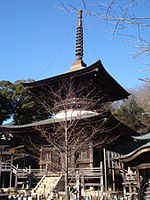 |
Rakuhō-ji tahōtō (楽法寺多宝塔)[22] | 1684 | Sakuragawa | Ibaraki Prefecture | 3 ken; originated in a three-storey pagoda of 1254, later ruined and rebuilt | Prefectural |
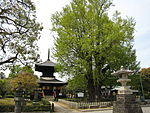 |
Banna-ji tahōtō (鑁阿寺多宝塔) | 1692 | Ashikaga | Tochigi Prefecture | 3 ken | |
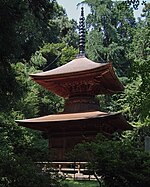 |
Kanasana Jinja tahōtō (金鑽神社多宝塔)[23] | 1534 | Kamikawa | Saitama Prefecture | 3 ken, shingle roof | ICP |
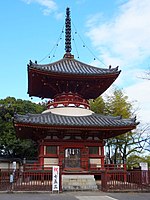 |
Kita-in tahōtō (喜多院多宝塔)[24] | 1639 | Kawagoe | Saitama Prefecture | 3 ken, tiled roof | Prefectural |
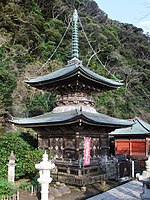 |
Nago-dera tahōtō (那古寺多宝塔)[25] | 1761 | Tateyama | Chiba Prefecture | 3 ken, copper roof | Prefectural |
| Ishidō-ji tahōtō (石堂寺多宝塔)[26] | 1548 | Minamibōsō | Chiba Prefecture | 3 ken, shingle roof | ICP | |
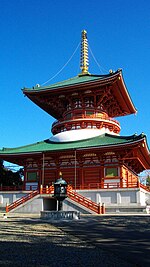 |
Narita-san daitō (新勝寺大塔) | 1984 | Narita | Chiba Prefecture | 5 ken | |
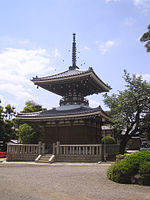 |
Gokoku-ji tahōtō (護国寺多宝塔)[27] | 1938 | Bunkyō | Tōkyō | 3 ken, tiled roof; modelled on that of Ishiyama-dera | |
 |
Ikegami Honmon-ji hōtō (池上本門寺宝塔)[28] | 1828 | Ōta | Tōkyō | ICP | |
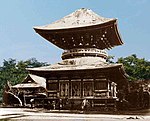 |
Tsurugaoka Hachiman-gū daitō (鶴岡八幡宮大塔) | Kamakura | Kanagawa Prefecture | 5 ken; destroyed | ||
 |
Nichiryūbu-ji tahōtō (日竜峯寺多宝塔)[29][30] | 1275-1332 | Seki | Gifu Prefecture | 3 ken, hinoki roof | ICP |
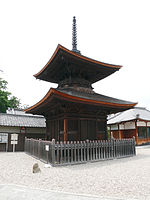 |
Kannon-ji tahōtō (観音寺多宝塔)[31][32] | 1536 | Nagoya | Aichi Prefecture | 3 ken, copper roof | ICP |
| Shōkai-ji tahōtō (性海寺多宝塔)[33][34] | 1393-1466 | Inazawa | Aichi Prefecture | 3 ken, copper roof | ICP | |
| Mantoku-ji tahōtō (万徳寺多宝塔)[35][36] | 1467-1572 | Inazawa | Aichi Prefecture | 3 ken, hinoki roof | ICP | |
 |
Senjō-in tahōtō (泉浄院多宝塔) | 1962 | Inuyama | Aichi Prefecture | 3 ken, tiled roof | |
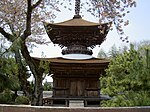 |
Daiju-ji tahōtō (大樹寺多宝塔)[37][38] | 1535 | Okazaki | Aichi Prefecture | 3 ken, hinoki roof | ICP |
 |
Chiryū Jinja tahōtō (知立神社多宝塔)[39][40] | 1509 | Chiryū | Aichi Prefecture | 3 ken, shingle roof | ICP |
| Tōkannon-ji tahōtō (東観音寺多宝塔)[41][42] | 1528 | Toyohashi | Aichi Prefecture | 3 ken, shingle roof | ICP | |
 |
Mitsuzō-in tahōtō (密蔵院多宝塔)[15][43][44] | 1393-1466 | Kasugai | Aichi Prefecture | 3 ken, shingle roof; dismantled for repairs in 1953, roof repairs in 1977 | ICP |
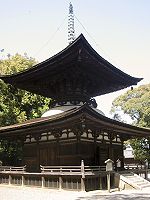 |
Ishiyama-dera tahōtō (石山寺多宝塔)[45][46][47][48] | 1194 | Ōtsu | Shiga Prefecture | 3 ken, hinoki roof; four painted pillars of the Kamakura period (ICP); inside are a Heian period and a Kamakura period wooden seated statue of Dainichi Nyorai, both (ICP) | National Treasure |
| Kontai-ji tahōtō (金胎寺多宝塔)[49] | 1298 | Wazuka | Kyōto Prefecture | 3 ken, shingle roof | ICP | |
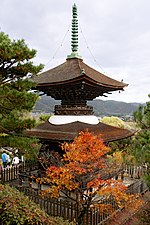 |
Jōjakō-ji tōba (常寂光寺塔婆(多宝塔))[49] | 1620 | Kyōto | Kyōto Prefecture | 3 ken, hinoki roof | ICP |
 |
Yoshimine-dera tahōtō (善峰寺多宝塔)[50] | 1621 | Kyōto | Kyōto Prefecture | 3 ken, hinoki roof | ICP |
| Hōtō-ji tōba (寶塔寺塔婆(多宝塔))[51] | 1438 | Kyōto | Kyōto Prefecture | 3 ken, tiled roof | ICP | |
 |
Honpō-ji tahōtō (本法寺多宝塔)[52] | 1808 | Kyōto | Kyōto Prefecture | 3 ken, tiled roof | Prefectural |
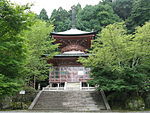 |
Hōrin-ji tahōtō (法輪寺多宝塔) | 1942 | Kyōto | Kyōto Prefecture | 3 ken, copper roof | |
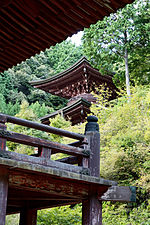 |
Jingo-ji tahōtō (神護寺多宝塔)[53][54] | 1935 | Kyōto | Kyōto Prefecture | 3 ken, tiled roof; inside are five Heian period wooden seated statues of Kokuzō Bosatsu (National Treasures) | |
 |
Chion-in tahōtō (知恩院多宝塔) | 1958 | Kyōto | Kyōto Prefecture | 3 ken, tiled roof | |
 |
Eikan-dō tahōtō (永観堂多宝塔)[55] | 1928 | Kyōto | Kyōto Prefecture | 3 ken | |
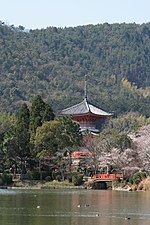 |
Daikaku-ji hōtō (大覚寺宝塔)[56] | 1967 | Kyōto | Kyōto Prefecture | 3 ken, tiled roof | |
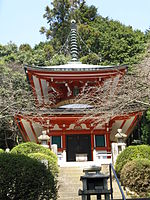 |
Kurama-dera tahōtō (鞍馬寺多宝塔)[57] | 1960 | Kyōto | Kyōto Prefecture | 3 ken; the previous tahōtō was destroyed in the late Edo period | |
 |
Sanmyō-in tahōtō (三明院多宝塔) | 1961 | Kyōto | Kyōto Prefecture | 3 ken, copper roof | |
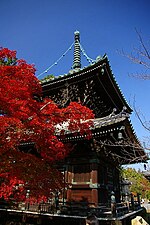 |
Seiryō-ji tahōtō (清凉寺多宝塔)[58] | 1702 | Kyōto | Kyōto Prefecture | 3 ken, tiled roof | Prefectural |
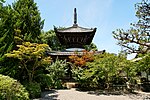 |
Anao-ji tahōtō (穴太寺多宝塔)[59] | 1804 | Kameoka | Kyōto Prefecture | 3 ken, tiled roof | Prefectural |
| Daifukukō-ji tahōtō (大福光寺多宝塔)[15][60] | 1275-1332 | Kyōtamba | Kyōto Prefecture | 3 ken, hinoki roof; dismantled for repairs in 1918, roof repairs in 1955 | ICP | |
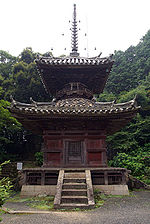 |
Enryū-ji tahōtō (円隆寺多宝塔)[61] | 1751 | Maizuru | Kyōto Prefecture | 3 ken, tiled roof | Prefectural |
 |
Chion-ji tahōtō (智恩寺多宝塔)[62] | 1500 | Miyazu | Kyōto Prefecture | 3 ken, shingle roof | ICP |
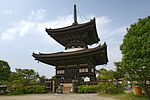 |
Shōman-in tōba (勝鬘院塔婆)[63] | 1597 | Ōsaka | Ōsaka Prefecture | 3 ken, tiled roof | ICP |
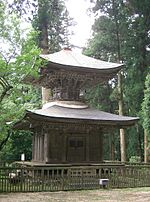 |
Iwawaki-dera tahōtō (岩湧寺多宝塔)[64][65] | 1467-1572 | Kawachinagano | Ōsaka Prefecture | 3 ken, copper roof; inside is a Heian period seated wooden statue of Dainichi Nyorai (ICP) | ICP |
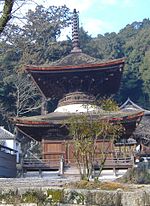 |
Kongō-ji tahōtō (金剛寺多宝塔)[66] | 1086-1184 | Kawachinagano | Ōsaka Prefecture | 3 ken, shingle roof | ICP |
 |
Jigen-in tahōtō (慈眼院多宝塔)[67] | 1271 | Izumisano | Ōsaka Prefecture | 3 ken, hinoki roof | National Treasure |
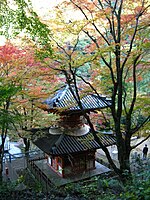 |
Daiitoku-ji tahōtō (大威徳寺多宝塔)[68] | 1515 | Kishiwada | Ōsaka Prefecture | 3 ken, tiled roof | ICP |
 |
Katsuō-ji tahōtō (勝尾寺多宝塔)[69] | 1987 | Minō | Ōsaka Prefecture | 3 ken, copper roof | |
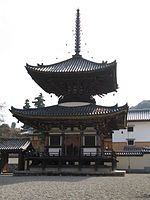 |
Hōdō-ji tahōtō (法道寺多宝塔)[15][70] | 1368 | Sakai | Ōsaka Prefecture | 3 ken, tiled roof; dismantled for repairs in 1921, roof repairs in 1969 | ICP |
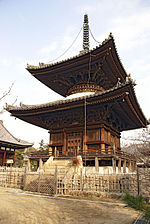 |
Eifuku-ji tahōtō (叡福寺多宝塔)[71] | 1652 | Taishi | Ōsaka Prefecture | 3 ken, tiled roof | ICP |
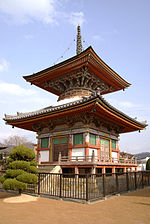 |
Sagami-ji tahōtō (酒見寺多宝塔)[72] | 1662 | Kasai | Hyōgo Prefecture | 3 ken, tiled lower roof, hinoki upper roof | ICP |
| Okusan-ji tahōtō (奥山寺多宝塔)[73] | 1709 | Kasai | Hyōgo Prefecture | 3 ken, tiled roof | Prefectural | |
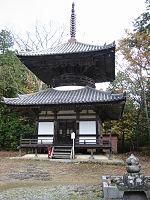 |
Chōkō-ji tahōtō (奥山寺多宝塔)[73] | 1710 | Katō | Hyōgo Prefecture | 3 ken, tiled roof | Prefectural |
 |
Tokkō-in tahōtō (徳光院多宝塔)[74] | 1478 | Kobe | Hyōgo Prefecture | 3 ken, tiled roof | ICP |
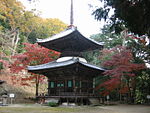 |
Gaya-in tahōtō (伽耶院多宝塔)[75] | 1648 | Miki | Hyōgo Prefecture | 3 ken, tiled roof | ICP |
| Renge-ji tahōtō (蓮花寺多宝塔)[73] | 1812 | Miki | Hyōgo Prefecture | 3 ken, hinoki roof | Prefectural | |
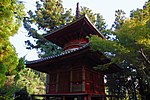 |
Tōkō-ji tahōtō (蓮花寺多宝塔)[73] | mid-Muromachi period | Miki | Hyōgo Prefecture | 3 ken, iron upper roof, tiled lower roof | Prefectural |
| Shōkon-ji tahōtō (荘厳寺多宝塔)[73] | 1715 | Nishiwaki | Hyōgo Prefecture | 3 ken, hinoki roof | Prefectural | |
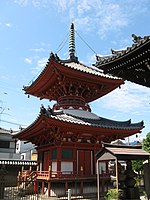 |
Chōon-ji tahōtō (長遠寺多宝塔)[76] | 1607 | Amagasaki | Hyōgo Prefecture | 3 ken, tiled roof | ICP |
 |
Onsen-ji tahōtō (温泉寺多宝塔) | 1767 | Toyooka | Hyōgo Prefecture | 3 ken, tiled roof | |
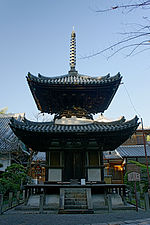 |
Kichiden-ji tahōtō (吉田寺多宝塔)[77] | 1463 | Ikaruga | Nara Prefecture | 3 ken, tiled roof | ICP |
| Kume-dera tahōtō (久米寺多宝塔)[78] | 1615-1660 | Kashihara | Nara Prefecture | 3 ken, shingle roof | ICP | |
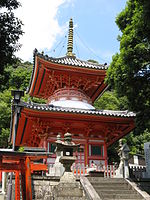 |
Chōgosonshi-ji tahōtō (朝護孫子寺多宝塔) | late Edo period | Heguri | Nara Prefecture | 3 ken, tiled roof | |
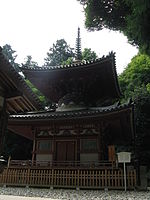 |
Hōzan-ji tahōtō (宝山寺多宝塔) | 1957 | Ikoma | Nara Prefecture | 3 ken, tiled roof | |
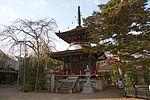 |
Tōnan-in tahōtō (東南院多宝塔)[79] | early Meiji period | Yoshino | Nara Prefecture | 3 ken, shingle roof | |
 |
Jison-in tahōtō (慈尊院多宝塔)[80] | 1624 | Kudoyama | Wakayama Prefecture | 3 ken, copper roof | Prefectural |
 |
Kōyasan Danjō Garan daitō (大塔)[3][9] | 1937 | Kōya | Wakayama Prefecture | 5 ken; five Buddhas of the Diamond Realm enshrined inside, with bodhisattva painted on the columns, in a form of mandala; the first daitō was completed in 837; it and four successors were destroyed by fire | |
 |
Kongōbu-ji Saitō (金剛峯寺西塔)[9] | 1834 | Kōya | Wakayama Prefecture | 5 ken, tiled roof; five Buddhas of the Womb Realm enshrined inside | |
 |
Kongōbu-ji Tōtō (金剛峯寺東塔) | 1984 | Kōya | Wakayama Prefecture | 3 ken | |
 |
Kongō Sanmai-in tahōtō (金剛三昧院多宝塔)[81][82] | 1223 | Kōya | Wakayama Prefecture | 3 ken, hinoki roof; inside are Kamakura period wooden seated statues of the Five Buddhas | National Treasure |
 |
Kimii-dera tahōtō (護国院多宝塔)[83] | 1449 | Wakayama | Wakayama Prefecture | 3 ken, tiled roof | ICP |
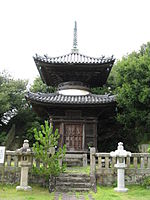 |
Kaizen-in tahōtō (海禅院多宝塔)[84] | 1653 | Wakayama | Wakayama Prefecture | 3 ken, tiled roof | |
 |
Negoro-ji tahōtō (daitō) (根来寺多宝塔(大塔))[85] | 1492-1554 | Iwade | Wakayama Prefecture | 3 ken, hinoki roof | National Treasure |
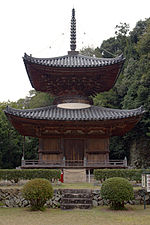 |
Jōmyō-ji tahōtō (浄妙寺多宝塔)[15][86] | 1275-1332 | Arida | Wakayama Prefecture | 3 ken, tiled roof; dismantled for repairs in 1935 | ICP |
 |
Chōhō-ji tahōtō (長保寺多宝塔)[15][87] | 1357 | Kainan | Wakayama Prefecture | 3 ken, tiled roof; dismantled for repairs in 1927 | National Treasure |
| Henshō-ji tahōtō (遍照寺多宝塔)[88] | 1606 | Kasaoka | Okayama Prefecture | 3 ken, tiled roof | ICP | |
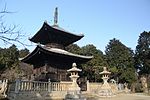 |
Rendai-ji tahōtō (蓮台寺多宝塔)[89] | 1670 | Kurashiki | Okayama Prefecture | 3 ken, tiled roof; rebuilt after a storm in 1843 | Prefectural |
| Anjū-in tahōtō (安住院多宝塔)[90] | 1688-1703 | Okayama | Okayama Prefecture | 3 ken, tiled roof | Prefectural | |
| Shōen-ji tōba (tahōtō) (静円寺塔婆(多宝塔))[91] | 1690 | Setouchi | Okayama Prefecture | 3 ken, tiled roof | Prefectural | |
 |
Mitaki-dera tahōtō (三瀧寺多宝塔)[92][93] | 1526 | Hiroshima | Hiroshima Prefecture | 3 ken, tiled roof; originally part of a Hachiman shrine in Wakayama Prefecture; relocated in 1951 in honour of the victims of the atomic bomb | Prefectural |
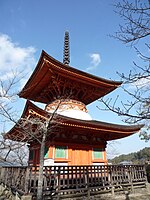 |
Itsukushima Jinja tahōtō (厳島神社多宝塔)[94][95] | 1523 | Hatsukaichi | Hiroshima Prefecture | 3 ken, shingle roof | ICP |
 |
Jōdo-ji tahōtō (浄土寺多宝塔)[15][96][97] | 1319-28 | Onomichi | Hiroshima Prefecture | 3 ken, tiled roof; dismantled for repairs in 1935, repainted in 1973 | National Treasure |
| Kōsan-ji tahōtō (耕三寺多宝塔)[98] | 1942 | Onomichi | Hiroshima Prefecture | 3 ken, copper roof; modelled on that of Ishiyama-dera | Registered | |
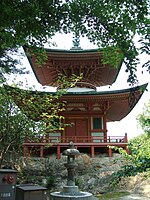 |
Buttsu-ji tahōtō (佛通寺多宝塔)[99] | 1927 | Mihara | Hiroshima Prefecture | 3 ken, copper roof | Registered |
| Akaibō tahōtō (閼伽井坊多宝塔)[100][101] | 1560 | Kudamatsu | Yamaguchi Prefecture | 3 ken, shingle roof; inscription with date found in 1928 | ICP | |
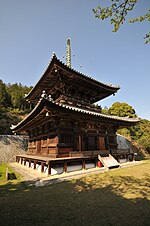 |
Kirihata-ji daitō (切幡寺大塔)[4][102] | 1618 | Awa | Tokushima Prefecture | 5 ken, twin-storey, tiled roof; pillars unusually arranged in a concentric square; relocated from Sumiyoshi Taisha in Ōsaka during the Meiji period | ICP |
 |
Yakuō-ji yugitō (薬王寺瑜祇塔)[103] | 1963 | Minami | Tokushima Prefecture | ||
 |
Kumadani-ji tahōtō (熊谷寺多宝塔)[104] | 1774 | Awa | Tokushima Prefecture | 3 ken, tiled roof | Prefectural |
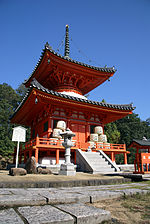 |
Yoda-ji tahōtō (與田寺多宝塔) | 1984 | Higashikagawa | Kagawa Prefecture | 3 ken, tiled roof | |
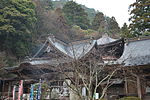 |
Ōkubo-ji tahōtō (大窪寺多宝塔) | 1954 | Sanuki | Kagawa Prefecture | 3 ken | |
 |
Dōryū-ji tahōtō (道隆寺多宝塔) | 1980 | Tadotsu | Kagawa Prefecture | 3 ken, tiled roof | |
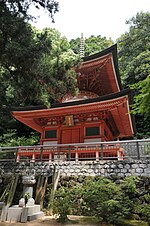 |
Yakuri-ji tahōtō (八栗寺多宝塔) | 1984 | Takamatsu | Kagawa Prefecture | 3 ken |
See also
References
- ^ a b c d Fujita Masaya, Koga Shūsaku, ed. (10 April 1990). Nihon Kenchiku-shi (in Japanese) (30 September 2008 ed.). Shōwa-dō. ISBN 4-8122-9805-9.
- ^ a b c "Houtou". Japanese Architecture and Art Net Users System. Retrieved 25 August 2010.
- ^ a b c d e Nicoloff, Philip L. (2008). Sacred Koyasan: A pilgrimage to the Mountain Temple of Saint Kōbō Daishi and the Great Sun Buddha. State University of New York Press. pp. 124–131, 301–3. ISBN 978-0-7914-7259-0.
- ^ a b c "Daitou". Japanese Architecture and Art Net Users System. Retrieved 25 August 2010.
- ^ "Database of National Cultural Properties (多宝塔)". Agency for Cultural Affairs. Retrieved 23 May 2011.
- ^ a b c d e f g h Soper, Alexander Coburn (1942). The Evolution of Buddhist Architecture in Japan. Princeton University Press. pp. 194–7.
- ^ a b c d e f "Tahoutou". Japanese Architecture and Art Net Users System. Retrieved 25 August 2010.
- ^ Hamashima, Masashi (1999). Jisha Kenchiku no Kanshō Kiso Chishiki (in Japanese). Tokyo: Shibundō. p. 74.
- ^ a b c Bogel, Cynthea J. (2009). With a Single Glance: Buddhist Icon and Early Mikkyō Vision. University of Washington Press. pp. 256f. ISBN 978-0-295-98920-4.
- ^ "Tasoutou". Japanese Architecture and Art Net Users System. Retrieved 23 May 2011.
- ^ "Mokoshi". Japanese Architecture and Art Net Users System. Retrieved 23 May 2011.
- ^ "Kamebara". Japanese Architecture and Art Net Users System. Retrieved 23 May 2011.
- ^ "Shitenbashira". Japanese Architecture and Art Net Users System. Retrieved 23 May 2011.
- ^ Suzuki, Kakichi (1980). Early Buddhist Architecture in Japan. Kodansha. pp. 18f. ISBN 0-87011-386-0.
- ^ a b c d e f g Parent, Mary (1983). The Roof in Japanese Buddhist Architecture. Weatherhill. pp. 128, 292f. ISBN 0-8348-0186-8.
- ^ a b "Sourin". Japanese Architecture and Art Net Users System. Retrieved 23 May 2011.
- ^ Hamashima, Masashi (1999). Jisha Kenchiku no Kanshō Kiso Chishiki (in Japanese). Tokyo: Shibundō. p. 224.
- ^ "Database of National Cultural Properties". Agency for Cultural Affairs. Archived from the original on 21 July 2012. Retrieved 23 May 2011.
- ^ "Database of National Cultural Properties". Agency for Cultural Affairs. Archived from the original on 24 July 2012. Retrieved 23 May 2011.
- ^ "Database of National Cultural Properties". Agency for Cultural Affairs. Archived from the original on 21 July 2012. Retrieved 23 May 2011.
- ^ "Ibaraki bunkazai". Ibaraki Prefecture. Archived from the original on 21 July 2011. Retrieved 23 May 2011.
- ^ "Ibaraki bunkazai". Ibaraki Prefecture. Archived from the original on 9 October 1999. Retrieved 23 May 2011.
- ^ "Database of National Cultural Properties". Agency for Cultural Affairs. Archived from the original on 20 July 2012. Retrieved 23 May 2011.
- ^ "Saitama bunkazai" (PDF). Saitama Prefecture. Archived from the original (PDF) on 27 September 2011. Retrieved 23 May 2011.
- ^ "Chiba bunkazai". Chiba Prefecture. Archived from the original on 21 July 2011. Retrieved 23 May 2011.
- ^ "Database of National Cultural Properties". Agency for Cultural Affairs. Archived from the original on 21 July 2012. Retrieved 23 May 2011.
- ^ "Gokokuji tahoto". Gokokuji. Archived from the original on 6 March 2001. Retrieved 23 May 2011.
- ^ "Database of National Cultural Properties". Agency for Cultural Affairs. Archived from the original on 21 July 2012. Retrieved 23 May 2011.
- ^ "Database of National Cultural Properties". Agency for Cultural Affairs. Archived from the original on 28 July 2012. Retrieved 23 May 2011.
- ^ "Gifu bunkazai". Gifu Prefecture. Retrieved 23 May 2011.
- ^ "Database of National Cultural Properties". Agency for Cultural Affairs. Archived from the original on 21 July 2012. Retrieved 23 May 2011.
- ^ "Kannonji tahoto". Aichi Prefecture. Retrieved 23 May 2011.
- ^ "Database of National Cultural Properties". Agency for Cultural Affairs. Archived from the original on 21 July 2012. Retrieved 23 May 2011.
- ^ "Shokaiji tahoto". Aichi Prefecture. Retrieved 23 May 2011.
- ^ "Database of National Cultural Properties". Agency for Cultural Affairs. Archived from the original on 20 July 2012. Retrieved 23 May 2011.
- ^ "Mantokuji tahoto". Aichi Prefecture. Retrieved 23 May 2011.
- ^ "Database of National Cultural Properties". Agency for Cultural Affairs. Archived from the original on 21 July 2012. Retrieved 23 May 2011.
- ^ "Daijuji tahoto". Aichi Prefecture. Retrieved 23 May 2011.
- ^ "Database of National Cultural Properties". Agency for Cultural Affairs. Archived from the original on 2 August 2012. Retrieved 23 May 2011.
- ^ "Chiryu Jinja tahoto". Aichi Prefecture. Retrieved 23 May 2011.
- ^ "Database of National Cultural Properties". Agency for Cultural Affairs. Archived from the original on 20 July 2012. Retrieved 23 May 2011.
- ^ "Tokannonji tahoto". Aichi Prefecture. Retrieved 23 May 2011.
- ^ "Database of National Cultural Properties". Agency for Cultural Affairs. Archived from the original on 1 August 2012. Retrieved 23 May 2011.
- ^ "Mitsuzoin tahoto". Aichi Prefecture. Retrieved 23 May 2011.
- ^ "Database of National Cultural Properties". Agency for Cultural Affairs. Archived from the original on 1 August 2012. Retrieved 23 May 2011.
- ^ "Database of National Cultural Properties". Agency for Cultural Affairs. Archived from the original on 24 July 2012. Retrieved 23 May 2011.
- ^ "Database of National Cultural Properties". Agency for Cultural Affairs. Archived from the original on 3 August 2012. Retrieved 23 May 2011.
- ^ "Database of National Cultural Properties". Agency for Cultural Affairs. Archived from the original on 23 July 2012. Retrieved 23 May 2011.
- ^ a b "Database of National Cultural Properties". Agency for Cultural Affairs. Archived from the original on 6 September 2012. Retrieved 23 May 2011.
- ^ "Database of National Cultural Properties". Agency for Cultural Affairs. Archived from the original on 20 July 2012. Retrieved 23 May 2011.
- ^ "Database of National Cultural Properties". Agency for Cultural Affairs. Archived from the original on 22 July 2012. Retrieved 23 May 2011.
- ^ "Honpoji tahoto". Kyoto Prefecture. Retrieved 23 May 2011.
- ^ "Database of National Cultural Properties". Agency for Cultural Affairs. Archived from the original on 23 July 2012. Retrieved 23 May 2011.
- ^ "Jingoji tahoto". Jingo-ji. Retrieved 23 May 2011.
- ^ "Eikando – History". Eikan-dō Zenrin-ji. Archived from the original on 23 July 2011. Retrieved 23 May 2011.
- ^ "Daikakuji – Buildings". Daikaku-ji. Archived from the original on 23 July 2011. Retrieved 23 May 2011.
- ^ "Kuramadera tahoto". Kurama-dera. Retrieved 23 May 2011.
- ^ "Seiryoji tahoto". Kyoto Prefecture. Retrieved 23 May 2011.
- ^ "Anaoji tahoto". Kyoto Prefecture. Retrieved 23 May 2011.
- ^ "Database of National Cultural Properties". Agency for Cultural Affairs. Archived from the original on 22 July 2012. Retrieved 23 May 2011.
- ^ "Maizuru tahoto". Kyoto Prefecture. Retrieved 23 May 2011.
- ^ "Database of National Cultural Properties". Agency for Cultural Affairs. Archived from the original on 27 July 2012. Retrieved 23 May 2011.
- ^ "Database of National Cultural Properties". Agency for Cultural Affairs. Archived from the original on 23 July 2012. Retrieved 23 May 2011.
- ^ "Database of National Cultural Properties". Agency for Cultural Affairs. Archived from the original on 3 August 2012. Retrieved 23 May 2011.
- ^ "Database of National Cultural Properties". Agency for Cultural Affairs. Archived from the original on 4 August 2012. Retrieved 23 May 2011.
- ^ "Database of National Cultural Properties". Agency for Cultural Affairs. Archived from the original on 28 July 2012. Retrieved 23 May 2011.
- ^ "Database of National Cultural Properties". Agency for Cultural Affairs. Archived from the original on 24 July 2012. Retrieved 23 May 2011.
- ^ "Database of National Cultural Properties". Agency for Cultural Affairs. Archived from the original on 30 July 2012. Retrieved 23 May 2011.
- ^ "Katsuoji tahoto". Katsuō-ji. Retrieved 23 May 2011.
- ^ "Database of National Cultural Properties". Agency for Cultural Affairs. Archived from the original on 21 July 2012. Retrieved 23 May 2011.
- ^ "Database of National Cultural Properties". Agency for Cultural Affairs. Archived from the original on 3 August 2012. Retrieved 23 May 2011.
- ^ "Database of National Cultural Properties". Agency for Cultural Affairs. Archived from the original on 24 July 2012. Retrieved 23 May 2011.
- ^ a b c d e "Hyōgo bunkazai" (PDF). Hyōgo Prefecture. Retrieved 23 May 2011.
- ^ "Database of National Cultural Properties". Agency for Cultural Affairs. Archived from the original on 21 July 2012. Retrieved 23 May 2011.
- ^ "Database of National Cultural Properties". Agency for Cultural Affairs. Archived from the original on 30 July 2012. Retrieved 23 May 2011.
- ^ "Database of National Cultural Properties". Agency for Cultural Affairs. Archived from the original on 29 July 2012. Retrieved 23 May 2011.
- ^ "Database of National Cultural Properties". Agency for Cultural Affairs. Archived from the original on 28 July 2012. Retrieved 23 May 2011.
- ^ "Database of National Cultural Properties". Agency for Cultural Affairs. Archived from the original on 22 July 2012. Retrieved 23 May 2011.
- ^ "Tonanin tahoto". Tōnan-in. Archived from the original on 29 September 2011. Retrieved 23 May 2011.
- ^ "Wakayama bunkazai". Wakayama Prefecture. Archived from the original on 22 May 2009. Retrieved 23 May 2011.
- ^ "Database of National Cultural Properties". Agency for Cultural Affairs. Archived from the original on 24 July 2012. Retrieved 23 May 2011.
- ^ "Database of National Cultural Properties". Agency for Cultural Affairs. Archived from the original on 21 July 2012. Retrieved 23 May 2011.
- ^ "Database of National Cultural Properties". Agency for Cultural Affairs. Archived from the original on 21 July 2012. Retrieved 23 May 2011.
- ^ "Kaizenin tahoto". Researcher. Retrieved 24 May 2011.
- ^ "Database of National Cultural Properties". Agency for Cultural Affairs. Archived from the original on 23 July 2012. Retrieved 23 May 2011.
- ^ "Database of National Cultural Properties". Agency for Cultural Affairs. Archived from the original on 30 July 2012. Retrieved 23 May 2011.
- ^ "Database of National Cultural Properties". Agency for Cultural Affairs. Archived from the original on 20 July 2012. Retrieved 23 May 2011.
- ^ "Database of National Cultural Properties". Agency for Cultural Affairs. Archived from the original on 22 July 2012. Retrieved 23 May 2011.
- ^ "Rendaiji tahoto". Kurashiki City. Retrieved 23 May 2011.
- ^ "Anjuin tahoto". Okayama City. Retrieved 23 May 2011.
- ^ "Shoenji tahoto". Setouchi City. Archived from the original on 24 July 2012. Retrieved 23 May 2011.
- ^ "Mitaki-dera". Hiroshima City. Retrieved 23 May 2011.
- ^ "Mitakidera tahoto". Hiroshima Prefecture. Archived from the original on 6 May 2009. Retrieved 24 May 2011.
- ^ "Database of National Cultural Properties". Agency for Cultural Affairs. Archived from the original on 21 July 2012. Retrieved 23 May 2011.
- ^ "Itsukushima Jinja tahoto". Hiroshima Prefecture. Archived from the original on 1 October 2011. Retrieved 23 May 2011.
- ^ "Database of National Cultural Properties". Agency for Cultural Affairs. Archived from the original on 30 July 2012. Retrieved 23 May 2011.
- ^ "Jodoji tahoto". Hiroshima Prefecture. Archived from the original on 19 December 2012. Retrieved 23 May 2011.
- ^ "Database of National Cultural Properties". Agency for Cultural Affairs. Archived from the original on 23 July 2012. Retrieved 23 May 2011.
- ^ "Database of National Cultural Properties". Agency for Cultural Affairs. Archived from the original on 22 July 2012. Retrieved 23 May 2011.
- ^ "Database of National Cultural Properties". Agency for Cultural Affairs. Archived from the original on 29 July 2012. Retrieved 23 May 2011.
- ^ "Akaibo tahoto". Yamaguchi Prefecture. Archived from the original on 12 August 2011. Retrieved 23 May 2011.
- ^ "Database of National Cultural Properties". Agency for Cultural Affairs. Archived from the original on 22 July 2012. Retrieved 23 May 2011.
- ^ "Yakuoji". Yakuōji. Archived from the original on 27 September 2011. Retrieved 23 May 2011.
- ^ "Tokushima bunkazai". Tokushima Prefecture. Archived from the original on 27 September 2011. Retrieved 23 May 2011.

